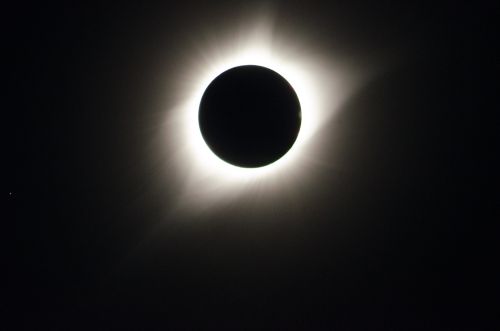
A little over five weeks ago, Carol and I threw the Pack into the Durango and blasted north for Colorado Springs. We spent a day there visiting, then passed off the Pack to Grandma Jimi (the breeder from whom we bought them) and headed north again. We didn’t drive past our old house. We decided, in fact, that we would never drive past our old house ever again. Closure is good, trust me on that.
We got the the Denver airport just in time to pick up my oldest friend Art, whom I had met in kindergarten, and who in 1969 had dragged me away from my pile of broken TV chassis long enough to meet my wife. All along northbound I-25 were dot-matrix signs from Colorado’s DOT, warning us about heavy eclipse traffic. Well, we had a plan for that. Instead of going straight north into Wyoming, we headed NE out I-76. We left I-76 at Sterling, Colorado, and drilled almost straight north into deepest Nebraska.
This was not an impulse. This was something I had had in mind since we began making plans for the trip several years ago. I had a hunch that most people would make a beeline for places where the path of totality crossed an Interstate. That’s why we didn’t keep going east to North Platte. And forgive me for being right: We saw very little traffic once we got away from I-25. Many other people we know, including Charlie Martin, got caught in some nasty traffic jams coming down I-25 from Casper, Wyoming. Not us. Nebraska’s backroads are excellent, and there was almost no one else on them. We reached Alliance, Nebraska about 3 PM the day before the eclipse. I had reserved a hotel room there a full year before, practically the day they began taking reservations. That was a good thing, as there are (I think) all of three hotels in the whole town.
With the hotel room squared away, we roared off to Wells Ranch, a few miles south of Alliance. There we met my high school friends Pete Albrecht and Ernie and Michelle Marek, along with their daughter Laura. Ernie had reseved space for us all at Wells Ranch, which had cleared one of their cattle pastures (you can guess what that entailed) and set up to receive as many as 1,000 visitors in tents, RVs, and trailers. Ernie brought his Airstream trailer, and Pete a tent. We had a nice little encampment fairly close to the portapotties and the building where the Wells people were providing hot meals, especially burgers and sausage made from (extremely) local beef.
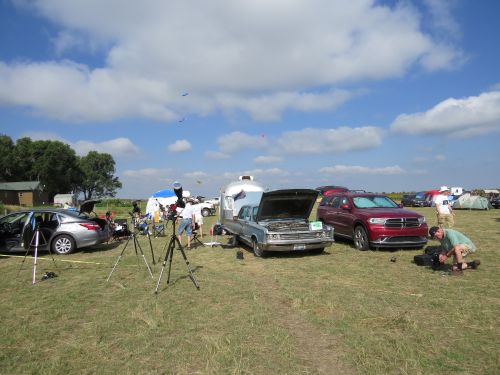
One startling thing we saw on pulling in was that the sky was full of kites. I hadn’t seen that many kites flying in one place since the old WIND kite festivals at Chicago’s Grant Park downtown while I was in college. I hadn’t thought to bring one, but a nearby camper had a few extras and I actually got to join the other campers in sculpting the sky, as they say.
Art did a little better than kites: He brought his professional-quality 4K video camera drone. He didn’t fly it a great deal, but he took some video footage and a few stills of the campers in the Wells pasture.
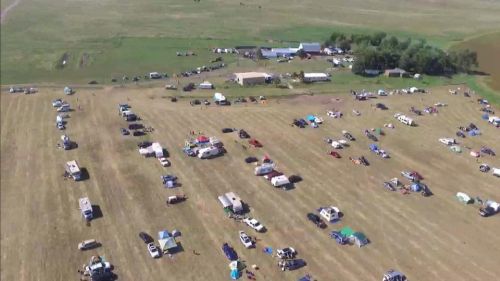
We spent an hour ot so catching up, and laying our plans for the next morning. Come five PM, we all piled into the car and headed back to Alliance. For that Sunday they had blocked off pretty much the entirety of their main street, and threw one helluva party. A local rock band played, and all the restaurants had tables and catering trucks outside. Beer flowed like water. It was a beer crowd, as you might expect; I looked in vain for wine.
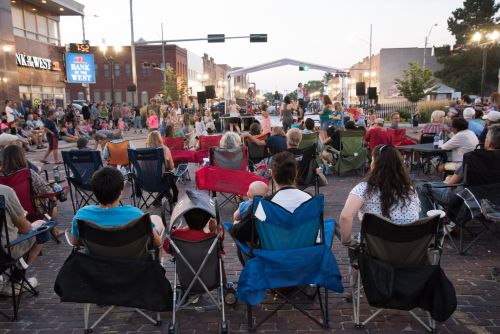
When Monday morning came, Alliance and its surrounds were covered in very dense fog. I got a little nervous at that point. Back in 1972, some friends and I (including Art and Ernie) had driven almost 2,000 miles to the mouth of the St. Lawrence River to see a total eclipse, only to be clouded out a mere hour before totality. The fog lifted eight-ish, with only a few scattered clouds remaining, and we began setting up our equipment.
Art, Pete, and Ernie are hobby photographers with fabulous cameras, filters, telephoto lenses, etc. I’m not. I didn’t plan to photograph totality at all. Instead, I brought my Criterion portable scope (which I had bought to see Halley’s Comet from Bonaire in 1986) and arranged it to project a magnified image of the Sun on a sheet of foamcore board. This worked very well for the partial phases of the eclipse. No need for glasses; we were never looking at the actual Sun.
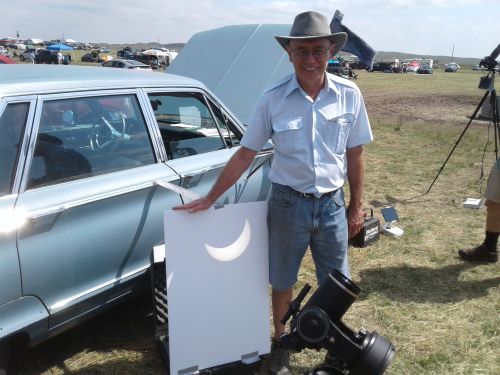
Partway through the partial phase, some denser and far less scattered clouds wandered in. My blood ran cold. This was how it had begun in 1972. Fearing that this was as good as it was going to get, I took a couple of remarkably good shots of the partial phase right through the clouds, with the clouds acting as their own solar filter. All I did was aim my Canon G16 at the sun, and snapped away on auto. But damn, I was worried.
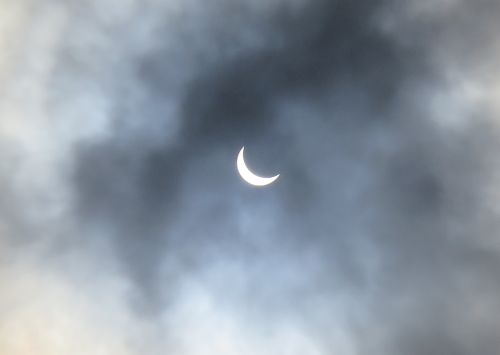
Very shortly after I took the shot above, the clouds dispersed in a hurry, as though God had leaned over the railings of Heaven and yelled “Shoo!” I stilled my pounding heart; it would not be 1972 redux.
As the partial phase of a total solar eclipse nears its end, the quality of the light changes. It gets “thin” in a weird way, which I have always characterized as “elfin.” Some people say it seems a touch green. It does seem more than a touch spooky. We put my spare sheet of white foamcore down flat on the ground, in hope of glimpsing the mysterious and hard-to-see shadow bands. Carol and I had seen them during the total solar eclipse of 1998, from a cruise ship in the Caribbean. It helps to have a large area of plain white to look for them. We had the side of a bright white ship, and the shadow bands were immdiately obvious in the last few seconds before totality. Nobody quite knows for sure what causes them; see the link above for several theories. The Sun became an ever-thinner sliver, putting the area into something like deep twilight. I looked at the foamcore, and damn! Shadow bands! They were hard to see and only lasted a few seconds, because then…
Totality.
Everybody all across Wells Ranch cheered. It got dark, but not midnight dark. Twilight-gray faded to a weird off-black. The Sun’s corona was much larger than I had predicted, and cast quite a bit of light all on its own. Yes, it really did look like Art’s photo at the beginning of this entry. During totality you can look at the Sun through a telescope, and we did. There were several pink-violet prominences at points around the Sun’s limb. You can see some in the photo below (from Pete Albrecht) if you look carefully:
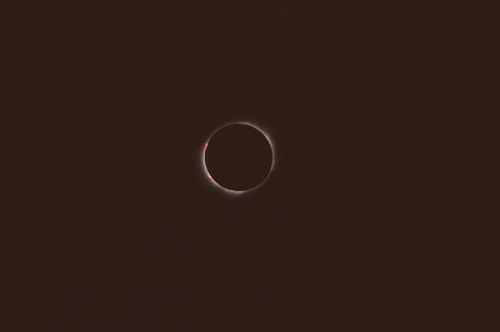
This was a short eclipse, with only a little more than two minutes of totality. I took some quick looks through the Criterion, but mostly I just stood and basked in the strangeness of the light and the weirdness of the corona. I wondered what our primitive ancestors might have thought, when chance placed them in an eclipse’s path. Were I even a hard-headed Neanderthal (and they were very hard-headed) I would have been hard-pressed not to ascribe the sight to supernatural activity.
And as a quick aside, I need to point out that eclipses of the sort we see are a consequence of a truly weird coincidence: That the Sun and the Moon present almost precisely the same angular diameter to people on Earth’s surface. A smaller Moon would merely transit the Sun’s disk. A larger Moon would have blocked out the prominences and even the corona. So why did it work out this way? Nobody knows. It seems an astonishingly unlikely thing. In truth, the Neanderthals’ guesses are pretty much as good as mine.
It lasted for two marvelous minutes and change. The end of totality is signaled by something no less astonishing than the eclipse itself: A dazzling point of light appears along the limb of the Sun, forming what people call the diamond ring effect. Like the shadow bands, it lasts only seconds, before the exposed point of the solar disk broadens to a slowly growing and painfully bright crescent. Again, people cheered, not so much because the eclipse was over, but because we had driven a long way to see it, and succeeded. (Unlike us in 1972.) This was my third total solar eclipse. I expect to make it four, come 2024. I hope to make it five, but more than that…unlikely. So I cheered with the whole gang scattered across the cowfields. We came. We watched. We triumphed.
Then it was over, and before the Moon moved entirely away from the Sun, people were throwing stuff into their cars and trailers and heading for the exits. I expected that, and it was the reason we had all decided to stay the rest of the day and the coming night in Alliance, so that the mad rush out of town would be other people’s problem.
And well that we did. That night, in the mostly empty cowfield, we were graced with some of the darkest skies any of us had ever seen. The air was clear, and apart from Alliance’s lights on the northern horizon, there was nothing to dull the stars. The Milky Way was as bright as I’d ever seen it. We leaned back in our lounge chairs and reminisced about Lane Tech, while spotting a few satellites and several very bright meteors, probably late Perseids.
Earlier in the afternoon, we had taken a quick trip a few miles north to Carhenge, one of the most peculiar things I’ve ever seen. Back in 1987, an eccentric artist created a model of Stonehenge, only made out of 1960s and 70s cars, all painted gray. There is something delightfully human and weirdly Rural American about it. Nobody would do something like Carhenge in the Seattle suburbs. Sure, it’s a tourist trap. We were tourists.
Worked as designed.
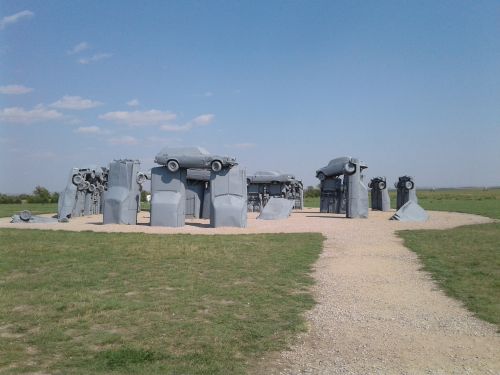
And so it ended. In a way, the expedition redeemed our ill-fated coming-of-age adventure to Cap Chat, Quebec, in 1972. Closure, as I said, is good. Pete took a photo of the three of us who had gone that time, along with a little blue souvenir flag that Ernie had somehow managed to retain for 45 years. Better late than never–and it had been well worth the wait.
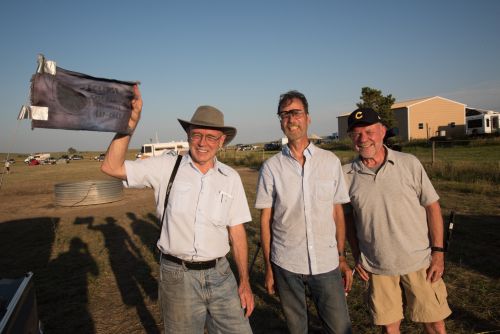











Well done! For me, 2017 redeemed my totally-clouded-out experience in Valdosta, Ga., in 1970. Like you, I chose a place off the Interstates (namely Hiawassee, Ga.).
Interesting idea about the last light of a deep partial eclipse being greenish. The solar photosphere does look different at the periphery; I will look back at some images and see if I can detect a color difference.
An excellent and well planned adventure. Good planning to avoid the traffic and spend quality time with friends! The feeling of the light definitely changes, becomes “cooler,” close to totality. Hard to describe, but you can definitely sense it.
My brother and I enjoyed the high school football field of Midvale, ID; the alma mater of my sister-in-law. Thanks to Midvale for a pleasant stay on nice green grass. It was a privilege to pay them $30/night to camp on the field with the proceeds supporting a school club. God bless small town schools that are K-12 with a total of only a couple of hundred students total.
Just as you say, avoiding traffic was easy if you stay off the interstate. I saw a lot of small towns and beautiful views I want to visit again. Eating bright red, cherry size wild plums along Oregon Rt. 86 is a delight. And I got to swerve along the road avoiding an army of Mormon crickets!
My big eclipse memory was the purplish horizon to horizon sky. And the impossibly small black dot of a Moon blocking out an incredibly small white dot Sun. Way cool. No photo does justice to the corona.
The evening of the eclipse I checked out Google maps and their highway traffic view. Across the country was a picket fence of red colored north-south interstates clogged with cars. I wish I had saved a screen shot.
I’m planning for 4/8/2024 in Sikeston, MI. Three minutes and thirty four seconds of totality! Maybe I’ll make reservations at the high school today.
What an adventure!
I traveled from Arizona to visit my family in Oregon where they live about 20 miles south of the totality track in the Willamette Valley. We had no plans other than to drive up country roads until we got into the zone but the night before we found a small town park via Google Maps and decided that was the spot. We got there a few hours prior to the event and found ample parking. I set up my trusty Edmunds Astroscan to project onto a white sketch pad my niece had brought. Passers-by were constantly commenting on the great view that provided.
The total eclipse was well worth the trip – the image of the corona as viewed by the naked eye is something I’ll keep with me. Pictures don’t do it justice – the colors, the shimmering quality. Amazing.
Afterward we took the same country roads back and had only minor traffic. Others in my family returned to Seattle via the interstate thru Portland and had rather more trouble. No one regretted the trip though.
Looks like a great trip Jeff! Glad to hear Ernie is still doing well.